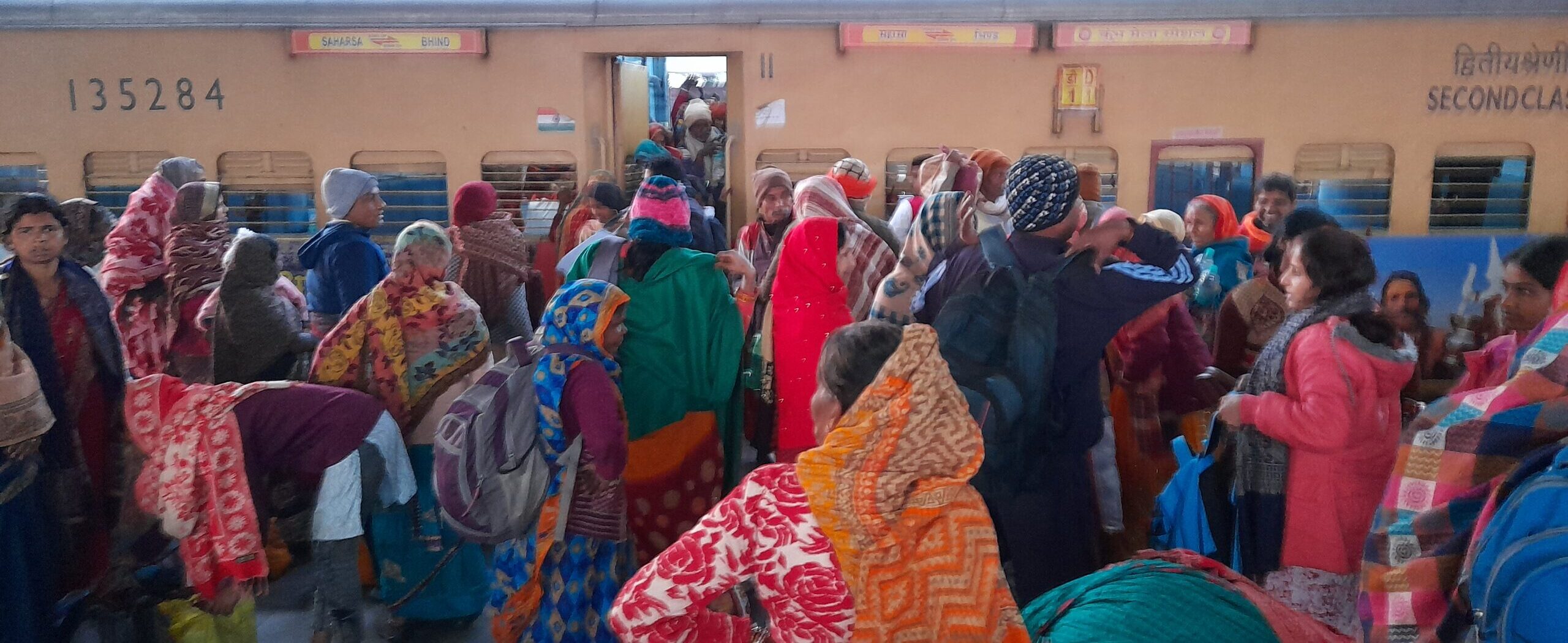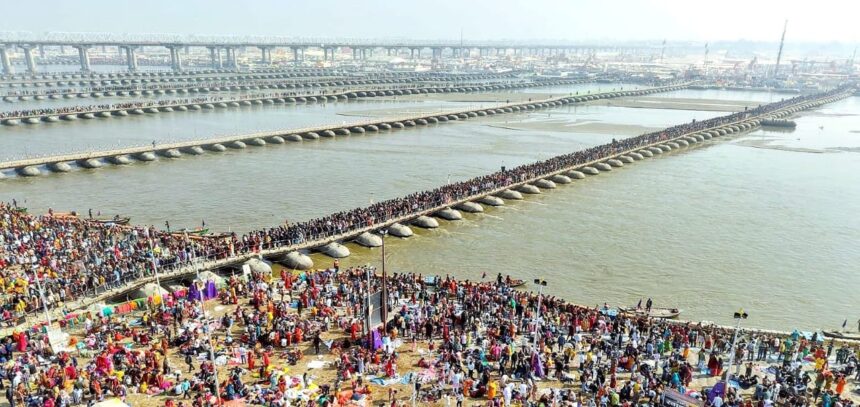Mahakumbha 2025: Observations, Challenges, and Reflections
Mahakumbha 2025: Appreciatiion and Critique
In my earlier exploration of Mahakumbha 2025 at HinduInfoPedia, I shared the profound spiritual journey I undertook, filled with personal revelations and divine encounters. Building on these deeply personal experiences, this blog delves into the broader spectacle of Mahakumbha—a grand confluence of faith, culture, and humanity. We transition from personal reflection to a critical analysis of the event’s infrastructure, management, and the diverse array of participants that contribute to the vibrant social dynamics of this grand pilgrimage. By juxtaposing my individual experiences with these broader observations, we gain a comprehensive understanding of the event’s splendor, its challenges, and the enduring legacy it leaves on its attendees.
Background of Mahakumbha 2025 critique
The Mahakumbha 2025, as described earlier, is a monumental event rooted in Hindu traditions, drawing millions to the sacred Triveni Sangam in Prayagraj. Steeped in the legend of the Samudra Manthan and guided by intricate astronomical calculations, it stands as a symbol of spiritual purification and cultural continuity. My first blog captured the essence of my spiritual encounters—unexpected yet profoundly impactful.
While my personal journey highlighted the spiritual magic of the Mahakumbha, a closer look at the event reveals a broader narrative: the intricate web of logistics, social dynamics, and cultural richness that both elevates and challenges this grand pilgrimage. What follows is an exploration of these facets, offering a critical lens on the experience shared by millions.
Infrastructure and Capacity for Mahakumbha 2025
1. Infrastructure Development:
- The infrastructure has been developed to a level that is beyond the imagination of an ordinary human being.
- The city and site infrastructure as it exists today is more than enough to handle twice the size of the crowd it handled on a single day, which was about 100 million.
- No risk of any security was noticed barring the one incident that was created allegedly by some miscreants rather than by the pilgrims themselves who maintain utmost restraint.
Social Observations and Myths
2. Gender and Religious Participation:

- The number of ladies visiting the holy site was at least three times that of men, an important issue for research.
- The presence of many women, traveling alone or in groups, challenges Western criticisms about gender discrimination in Hindu societies.
3. Caste System Myth:
- The event also debunked myths about the caste system in Hinduism, showing unity among pilgrims and vendors regardless of caste.
4. Visitor Profiles:
Summary of the broad visitor profiles at Mahakumbha 2025
- Total Visitors so Far: Estimates suggest around 40 to 45 crore (400 to 450 million) attendees over the duration of the event, making it one of the largest gatherings in the world.
Demographic Composition:
- Gender: There was a significant presence of women, with observations indicating that women outnumbered men by at least three times.
- Age: Attendees ranged from young children to the elderly, including many senior citizens like yourself who faced challenges with mobility.
Geographical Spread:
- Domestic: Pilgrims from all over India, including states like Uttar Pradesh, Bihar, Madhya Pradesh, and Maharashtra, among others.
- International: Visitors from at least 183 countries, with significant numbers from Europe, North America, and Africa. Countries with notable delegations or visitors include Australia, Bhutan, Brazil, Canada, Fiji, Finland, France, Germany, Guyana, Indonesia, Japan, Malaysia, Mauritius, Nepal, Russia, Singapore, South Africa, Sri Lanka, UAE, UK, and USA.
Socioeconomic and Cultural:
The event attracted people from diverse socioeconomic backgrounds, including:
- Spiritual Leaders and Sadhus: Various Akharas participated, including the Juna Akhara (one of the largest) and the Kinnar Akhara, which drew attention for its unique practices.
- General Public: A vast majority were ordinary devotees seeking spiritual purification, including families, groups of friends, and lone pilgrims.
- Professionals and Scholars: Journalists, researchers, and scholars interested in studying the cultural, religious, and social aspects of the event.
- Tourists: Both domestic and international tourists looking for cultural experiences.
Special Groups:
- Kalpvasis: Over 10 lakhs were present, living in temporary camps for spiritual practices.
- Foreign Delegations: Diplomatic and cultural delegations from various countries, with a specific mention of a 21-member delegation from 10 countries participating in cultural activities.
Participation in Rituals:
The event saw participation in various rituals like the Divya Snan (royal bath), with significant gatherings on auspicious dates like Mauni Amavasya, Basant Panchami, Jaya Ekadashi and Maha Shivratri.
Technology Users: With the event being dubbed ‘Digital Mahakumbh,’ there were many visitors using the official website, apps, and digital services for navigation, booking accommodations, and getting information.
Safety, Hygiene, and Special Needs
5. Safety and Hygiene:
- No significant problems noted from a personal perspective, though some raise concerns.
- There were many issues of loss of items and companions in the central place of activity, that is, Triveni Sangam. However there are no reports of theft of items even though not very secure vigilance as possible by every pilgrim.
- Minor incidents do not overshadow the scale of the event, hence dismissed as minor concerns.
Logistical Concerns at Mahakumbha 2025
6. Accommodation and Facilities:
- Adequacy of Accommodation: The management has stated and advised that there was adequate accommodation available for pilgrims, and this claim appears trustworthy.
- Transparency Issues: However, there is a significant issue with the lack of transparency in both accommodation pricing and the dissemination of related information.
- Information Centralization: Due to the lack of a centralized system for sharing information about accommodation availability, it is difficult for pilgrims to find and secure lodging when needed, where needed.
- This lack of information helped make quick buck for the more influential few.
- The official Kumbh site had no information about it.
- Train Travel: While there is a flooding of Kumbh Special trains for meeting the travel requirements it is essential to appreciate that many pre-scheduled trains are made to miss schedules thereby creating problems. The train I travelled in from Delhi to Prayagraj reached two hours late and the train I travelled back to Delhi, a Rajdhani class was delayed by
7. VIP Culture and Management:
- Management states that VIP movement is literally stopped. This statement seems to be true.
- Despite the above fact, undeclared VIPs or more influential and privileged in the society still pose a nuisance.
8. Transportation and Navigation:
- Real concerns about transportation and navigation persist, affecting everyone.
- Lack of Arrival and Exit Strategies: There was a complete absence of organized arrival and exit plans for pilgrims at central locations like railway stations, airports, and major bus terminals.
- Chaos in Connectivity to Other Pilgrimage Sites: The journey from Kumbh Mela to other significant pilgrimage sites such as Ayodhya and Varanasi was disorganized and chaotic.
- Transparency in charges of local services for travel was absent altogether.
- There was total absence of local transport owing to the writ applied by police to control the traffic and crowd.
- Lack of special provisions for the ailing and elderly, treating everyone with the same harsh measures despite different physical capabilities.
9. Communication and Information:
- Lack of coordination among police at different points; one policeman managing one control point does not know what others are doing.
- Minimal use of announcements for crowd control and guidance; the few announcements heard were often related to traffic or police instructions to stop movement of traffic and crowd rather than aiding pilgrims.
Crowd and Traffic Management at Mahakumbha 2025
- The management has totally forgot the difference between “management” and “control” and have assumed that control is same as management. It has had disastrous consequences on the pilgrims’ experience.
- Absence of Arrival and Exit plan for pilgrims from central locations such as Railway Stations, Airport and central bus stands etc was totally absent.
- Arrival and to other famous pilgrimage sites the places line Ayodhya and Varanasi was totally messed up.
- Policemen and security personnel worked in groups rather than being spread out. While grouping is crucial for the safety of the officers themselves, this strategy reduced their effectiveness in serving and managing the public efficiently.
10. Police and Crowd Control for Mahakumbha 2025
- There is no traffic and crowd management; it is only controlled by the police using the baton and iron fist, though these are not actually utilized due to public discipline.
- Use of police and forces alone to control the crowd without knowledge on the subject has brought disastrous experiences to every pilgrim’s journey, with everyone having a painful experience, though accepted without complaints.
- Police are ill-informed, with little knowledge of what other units are doing in terms of crowd and traffic control.
- Police are ill-trained to handle and manage crowd and traffic but control them effectively by stalling and impeding movement.
- The writ of police is too harsh, as seen in instances where they forced pilgrims to move unnecessarily.
- The stoppage of traffic, especially near critical points like railway stations, is an inhumane act, exemplified by the hardship faced by a young disabled girl and an elderly person like yourself.
Other Concerns
11. Environmental Stewardship at Mahakumbha 2025
The environmental impact of an event as colossal as Mahakumbha cannot be overlooked. Fortunately, India’s knack for recycling plays a pivotal role in mitigating waste. At Prayagraj, the commitment to sustainability was evident. Materials used for temporary constructions, such as plywood and steel, were repurposed or sold post-event. Even smaller items like pavement blocks, used temporarily for infrastructure needs, were recycled. This not only reflects an efficient use of resources but also highlights a community-oriented approach to environmental management. Such measures showcase the profound respect for nature intertwined with the spiritual essence of Mahakumbha, aligning with broader environmental ethics.
Economic Impact of Mahakumbha 2025
The Mahakumbha 2025 was not just a spiritual and cultural phenomenon; it was also an economic powerhouse. With an estimate of 40 to 45 crore (400 to 450 million) visitors already achieved 20 days before finish, the event generated substantial economic activity, particularly for the local economy of Prayagraj and the broader region. Reports indicate that the festival’s economic impact could range between ₹2 lakh crore to ₹4 lakh crore ($25-50 billion), potentially contributing up to 1% to India’s GDP for the year.
Local Businesses and Employment: Small-scale vendors, including rickshaw pullers, food stall owners, and souvenir sellers, saw a massive surge in demand. The hospitality sector, encompassing hotels, guesthouses, and temporary tent accommodations, reportedly generated ₹40,000 crore. Over 12 lakh temporary and gig jobs were created, spanning sectors like sanitation, security, and logistics, providing a significant boost to local livelihoods.
Infrastructure Investments: The Uttar Pradesh government allocated approximately ₹6,382 crore for infrastructure development, including the construction of roads, sanitation facilities, and temporary accommodations. This investment not only facilitated the event but also promises long-term benefits by enhancing the city’s capacity to host future gatherings.
Trade and Commerce: The Confederation of All India Traders (CAIT) estimated that daily essentials like food and beverages contributed ₹20,000 crore, while religious items and offerings added another ₹20,000 crore to the economy. Even niche sectors, such as boat operators ferrying pilgrims across the river, saw daily earnings soar.
National and Global Ripple Effects: Beyond Prayagraj, the Mahakumbha’s economic influence extended to sectors like railways, aviation, and tourism, with increased travel to nearby pilgrimage sites like Ayodhya and Varanasi. The influx of international visitors—over 15 lakh from 183 countries—further boosted India’s cultural tourism, leaving a lasting impression on the global stage.
This economic footprint underscores the Mahakumbha’s dual role as a spiritual sanctuary and an economic engine, driving growth and opportunities for millions while reinforcing the region’s status as a cultural and economic hub.
The above narrative is merely anecdotal. There is a need to have detailed exploration of each of the above components so that one can fully comprehend the subject.
Reflections on critical analysis of Mahakumbha 2025
Mahakumbha 2025 offered a profound blend of spiritual insights and tangible challenges, embodying a vivid tableau where divinity intertwines with the practicalities of human organization. While we reveled in the cultural and spiritual profundities, the event also underscored the urgent need for enhancements in management and logistics. Our exploration into the multifaceted nature of Mahakumbha is just beginning. Stay tuned as we continue to unravel these complexities in upcoming posts, each dedicated to dissecting different facets of the festival. I invite you to join this journey to fully appreciate the intricate tapestry of tradition and modernity that Mahakumbha weaves. Connect with us through HinduInfoPedia and our social media channels to ensure you don’t miss any updates.
Feature Image: Click here to view the image.
Visit our Youtube Channel by clicking here.
Click here to visit the related page on Medium.com
Follow us on our social median handles
Glossary of Terms
- Mahakumbha: Also known as Kumbh Mela, this is a major pilgrimage and festival in Hinduism that occurs four times over a 12-year cycle and is celebrated at four different riverbank pilgrimage sites: Prayagraj, Haridwar, Nashik, and Ujjain.
- Triveni Sangam: The confluence of three rivers, specifically the Ganges, Yamuna, and the mythical Saraswati, located in Prayagraj (formerly known as Allahabad). It is considered one of the holiest places in Hinduism.
- Samudra Manthan: A mythological event from Hindu scripture where the gods and demons churn the ocean of milk to obtain Amrita (the nectar of immortality). This story is symbolic of the spiritual quest for immortality through devotion and diligence.
- Astronomical Calculations: Refers to the calculations made based on the positions of planets and stars used to determine the most auspicious dates for the Mahakumbha.
- Divya Snan: Literally translates to ‘divine bath’. It refers to the sacred bathing during the Kumbh Mela, which is believed to cleanse sins and lead to salvation.
- Kalpvasis: Pilgrims who live at the pilgrimage site for the entire duration of the Kumbh Mela, engaging in daily prayers and bathing ritually in the river. The term comes from ‘Kalpa’, which means a long period of time in Hindu cosmology, signifying their dedication.
- Akhara: A traditional school or order of religious ascetics in Hinduism, where Sadhus (monks) belong to various sects are trained in spiritual practices and arms. Akharas play a central role in the ceremonies of Mahakumbha.
- Kinnar Akhara: A relatively new group within the Kumbh Mela representing transgender and third-gender ascetics, highlighting the inclusivity of the event.
- VIP Culture: Refers to the preferential treatment given to important persons, which can sometimes disrupt the traditional and egalitarian spirit of the gatherings like Mahakumbha.
Top #tags: #Mahakumbha2025 #SpiritualJourney #HinduFestivals #CulturalHeritage #IndianSpirituality



Leave a Reply